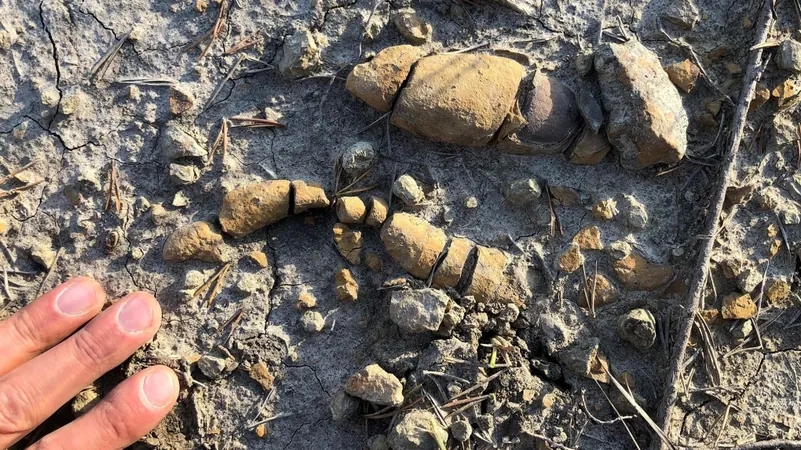
Unveiling the Secrets of Dinosaur Dominance Through Fossilized Feces
2024-11-27
Author: Charlotte
Introduction
Recent research has provided groundbreaking insights into the rise of dinosaurs, revealing that the secrets to their evolutionary success may be hidden in their ancient droppings. When dinosaurs first appeared around 230 million years ago, they were relatively inconspicuous creatures among a plethora of other reptilian life forms. However, within just 30 million years, they had transformed the Earth into their domain, adapting and evolving into a staggering array of shapes and sizes.
The New Approach to Research
The definitive reasons behind their unparalleled success have puzzled scientists for decades. A team led by paleontologist Martin Qvarnström at Uppsala University in Sweden has taken a fresh approach, analyzing fossilized remnants known as bromalites—essentially, dinosaur poop and vomit. Their study, recently published in the journal *Nature*, took over a decade and involved inspection of more than 500 fossils collected from ten sites across the Polish Basin, dating from the Late Triassic to the early Jurassic Period (approximately 247 to 200 million years ago).
Significance of Bromalites
Bromalites are an unexpected treasure trove of paleoecological information. Qvarnström noted that these fossils have often been overlooked, treated as curiosities rather than serious sources of scientific insight. However, through meticulous examination, researchers found that the size and variety of coprolites increased over time, which correlates directly with the emergence of larger dinosaurs and a more diverse diet.
Connecting the Dots
By carefully studying these ancient droppings and linking them with fossilized skeletons and footprints, the research team was able to reconstruct the types and numbers of dinosaurs inhabiting the regions at specific times. Their analysis indicates a clear transition from a world populated by few dinosaurs to one in which they were the dominant species.
Advanced Analysis Techniques
This examination went deeper than simple visual identification. Utilizing advanced 3D scanning technology at the European Synchrotron Radiation Facility in France, scientists could analyze the internal structure of the bromalites to understand their contents. The findings revealed a mixture of preserved remains—fish, insects, and even plant matter—offering a glimpse into the dietary habits of these enormous reptiles.
Critical Phases in Dinosaur Evolution
Remarkably, the comprehensive study highlighted five critical phases in the evolution of dinosaurs. Initially, their ancestors were omnivorous. Over time, they evolved into the first true carnivorous and herbivorous dinosaurs. One pivotal turning point was an increase in volcanic activity, which spurred an explosion of plant diversity, laying the groundwork for the rise of large herbivorous dinosaurs. This, in turn, led to the emergence of massive carnivorous species as we imagine today.
Competition and Adaptability
The study provides an intriguing perspective on the competition dinosaurs faced. Prior theories suggested that dinosaurs either evolved superior physical traits to outcompete other reptiles or were simply more adaptable to the environmental shifts of the time. Qvarnström’s findings propose a hybrid model, suggesting a complex interplay of several evolutionary processes allowed dinosaurs to thrive where their competitors could not.
Lessons from the Past
As part of the findings, it was noted that while dinosaurs enjoyed a varied diet, some of their contemporaries, like dicynodonts, had very specialized feeding habits, limiting their survival and leading to their eventual extinction around the same time the first true dinosaurs roamed.
Conclusion and Modern Relevance
So, what can we learn from these prehistoric revelations? According to Qvarnström, the message is timeless and resonates with modern dietary wisdom: 'Eat your veggies and live longer.' The study not only deepens our understanding of dinosaur evolution but also emphasizes the significant roles played by dietary diversity and adaptability in species survival, lessons that ring true even in today’s ecological battles.
Future of Paleontological Studies
As paleontologists continue to dive deeper into the lives of these magnificent creatures, one thing remains certain: the remnants of their past hold the keys to understanding the dynamic story of evolution and survival on Earth.









 Brasil (PT)
Brasil (PT)
 Canada (EN)
Canada (EN)
 Chile (ES)
Chile (ES)
 España (ES)
España (ES)
 France (FR)
France (FR)
 Hong Kong (EN)
Hong Kong (EN)
 Italia (IT)
Italia (IT)
 日本 (JA)
日本 (JA)
 Magyarország (HU)
Magyarország (HU)
 Norge (NO)
Norge (NO)
 Polska (PL)
Polska (PL)
 Schweiz (DE)
Schweiz (DE)
 Singapore (EN)
Singapore (EN)
 Sverige (SV)
Sverige (SV)
 Suomi (FI)
Suomi (FI)
 Türkiye (TR)
Türkiye (TR)